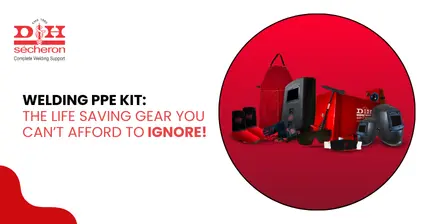
In the world of welding, durability is a crucial factor in judging the use of welding equipment. The 7018 electrode meets this standard well. However, it is more than just a durable option. In this blog, let's explore why the 7018 welding electrode is a top choice among welding professionals.
Reason 1: Superior Weld Quality
One of the most noteworthy features of the 7018 welding electrode is its ability to produce industry-standard welds. With a high tensile strength standing at 70,000 psi (70 in 7018 refers to tensile strength), welds can withstand significant stresses, making them ideal for structural applications. The low hydrogen content also lowers the risk of hydrogen-induced cracking. Thus, the result is a clean, aesthetically pleasing weld with minimal splatter, reducing post-weld cleaning time.
Reason 2: Versatility Across Applications
The 7018 electrode is widely used because it can be used in various ways. It is compatible with an array of welding consumables, such as metals, carbon steel, and low-alloy steel, making it suitable for all welding positions from flat, horizontal, vertical, and overhead. This makes it an excellent choice in complex constructions where different materials are used, such as shipbuilding, construction, and heavy equipment manufacturing.
Reason 3: Enhanced Mechanical Properties
The 7018 electrode exhibits superior welding qualities with its combination of low hydrogen content and content and iron powder coating. This makes it extremely tough and suitable for load-bearing structures. This welding electrode's performance is also excellent, even under extreme conditions such as sub-zero temperatures.
Reason 4: Ease of Use
All professionals favour this welding electrode due to its user-friendly characteristics. It offers good arc control, allowing welders to maintain a stable arc throughout welding. Furthermore, the minimal clean up required after the weld saves effort and time.
Reason 5: Reliability in Critical Environments
The 7018 wedding electrode is reliable. This fact cannot be overstated. Its composition prevents cracking and maintains structural integrity for longer durations, reducing the need for repeated maintenance and making it a safe choice for welders. It is also resistant to moisture and oxygen, ensuring the weld fulfils its function over time.
Tips for Working With 7018 Electrode Effectively
To get the most out of utilising the 7018 electrodes, follow these tips:
1. Appropriate storage: A clean, cool, and dry environment will prevent moisture absorption, reducing the chances of defects in weld quality.
2. Electrode Preparation: Keep welding electrodes contaminants free. Prevent contact with elements like oil and rust.
3. Preheating: When welding thicker sections or high-strength steels, it is best practice to use preheating to reduce the chances of cracking induced by hydrogen.
4. Optimal Welding Parameters: For best results, adjust welding parameters like current and voltage according to specifications provided by weld manufacturers.
With its various benefits making it a strong, durable, easy-to-use option that efficiently produces clean and visually appealing results, 7018 welding electrodes are undoubtedly the gold standard for welding professionals of all levels.
Are you looking for a trusted welding equipment manufacturer to source welding equipment like 7018 electrodes ? Start by exploring our welding material range now!
11 May 2025 | Welding
An In-Depth Exploration of Low-Alloy Steel: Your Comprehensive Guide
11 May 2025 | Welding
Nagpur - Bori - Tuljapur Road MSH-3 in Yavatmal District (Maharashtra)
11 May 2025 | Welding
Guidelines to Understand Gas Welding: Applications, Advantages & Disadvantages
11 May 2025 | Welding
3 Tips for Finding the Best Mild Steel Electrode for Your Application
11 May 2025 | Welding
How to Select the Right Welding Filler Wires for Stainless Steel Welding?
11 May 2025 | Welding
Building the Narendra Modi Stadium with Norma V and Autotherme-1 Electrodes
11 May 2025 | Welding
Low Alloy Steel Welding in a (PEB) Pre Engineered Building Structure
11 May 2025 | Welding
Welding Rods: Different Types and Tips for Properly Storing and Handling
11 May 2025 | Welding
Tips for Flawless Welds with Stainless Steel Electrodes: Pros and Cons
11 May 2025 | Welding
Exploring Applications and Benefits of Stainless Steel Welding Electrodes
11 May 2025 | Welding
Welding Basics: Joining Metals with Heat and Pressure - A Beginners Guide
11 May 2025 | Welding
Distinguishing Low-Alloy Steel from High-Alloy Steel: Understanding the Variations
11 May 2025 | Welding
Hard Facing Wire - Understanding the Process and Achieving Optimal Result
11 May 2025 | Welding
Exploring the Advantages of Stainless Steel Electrodes in Welding Applications
11 May 2025 | Welding
Weathering Steel vs. Traditional Steel: A Comparative Analysis of Performance
11 May 2025 | Welding
Choosing the Right Welding Rod: Why 6013 Electrodes Might Be Your Ideal Option
11 May 2025 | Welding
Why 7018 Electrodes Are Preferred for High-Strength Welds in Pipeline Construction
11 May 2025 | Welding
Filler Wire vs. Stainless Steel Filler Wire: Understanding the Key Differences
11 May 2025 | Welding
Exploring the Impact of Filler Material on Welding Quality and Durability
11 May 2025 | Welding
Choosing the Right Cast Iron Electrode for Different Welding Projects
11 May 2025 | Welding
Top Advantages of Cast Iron Electrodes for Industrial Welding Applications
11 May 2025 | Welding
Key Benefits and Challenges of Using TIG Welding in Industrial Projects
11 May 2025 | Welding
Top 5 Advantages of Flux Cored Arc Welding for Heavy-Duty Applications.png)
11 May 2025 | Welding
Lotherme-601: A Game-Changer for Restoring Shoulder Pins in Heavy Machinery
11 May 2025 | Welding
How D&H Sécheron Helped Repair a Rotary Kiln’s Cooler Section with LoTherme 352
11 May 2025 | Welding
Piston Repair for Mining Industry: Cost-Effective Solutions with LoTherme 468.webp)






.jpg)








































.jpg)
.jpg)

.jpg)

.jpg)





.jpg)
.jpg)
.jpg)



.webp)
.jpg)
.jpg)
.webp)
.jpg)






















.png)



.webp)

.webp)
.webp)



